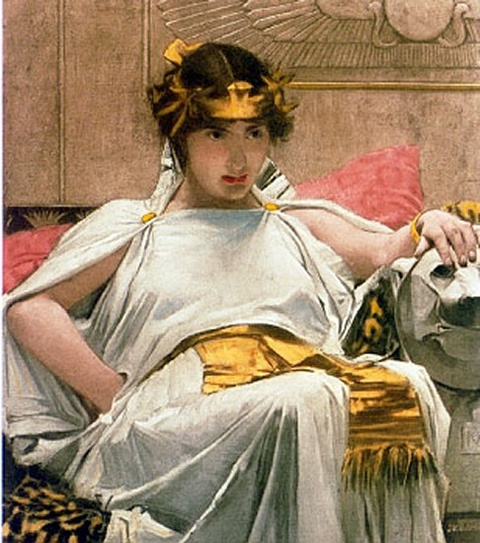First, the practical production problem: we still lack a costume designer, and it's becoming increasingly clear that no one is willing to take on the responsibility when the cast is so big, the costumes are period, and the Walterdale wardrobe has so little from that era. Everyone agrees that Antony & Cleopatra deserves to be a sumptuous visual spectacle...but no one is willing to take charge of that sumptuousness (at least not where costumes are concerned).
I've been wracking my brain trying to come up with a fix for this. One option is to set the production in a different period altogether -- some historical or contemporary setting that Walterdale already has ample supplies of in our wardrobe. But a decision like that requires an equally strong artistic concept backing it up. There's nothing worse than a Shakespearean production wallowing in post World War I Europe or floating in some vaguely medieval limbo if there isn't some strong, supportable reason for connecting that play with that period. Modernizing the play is also fraught with problems, because then you have to explain the presence of swords amidst 21st century battle gear (or else use the word "sword" to describe the machine guns in everybody's hands). In any case, nobody wants to see Cleopatra in a modern evening gown; they want to see her in her own historical grandeur.
However, a clever designer has a bit of an out, here, because most people don't know exactly what that historical grandeur is supposed to look like -- only that it's not like anything we see today. Most theatregoers have a vague sense of Roman attire, but Egyptian fashion? Hard to place. They could involve a lot of gold, like Tutenkhamen's sarcophagus; or they could involve brightly coloured, flowing fabrics, like images of Persian or Arabian cultures; or they could be quite simple, like the white cloth tunics seen in most hieroglyphics. (Historically, Cleopatra probably dressed more like a Greek noblewoman than an Egyptian goddess.)
Where am I going with this? I'm dancing around the notion that Egypt and Rome can be signified by relatively simple and basic images -- a coloured fabric here, a tunic there, maybe some gold jewelry, and so on. But that doesn't account for the rest of the clothing (actors need to wear something, after all). Nor does it provide the spectacle which audiences expect with a play like this.
I'll get back to this problem in a moment. In the meantime, there's another challenge, this time of an artistic nature. It involves the tension between characters' public and private personas -- a tension which pervades the play, as Antony & Cleopatra struggle to resolve their private love for each other with their public responsibilities to their respective realms. There are a number of ways to demonstrate this tension onstage -- through voice, through physical stance, etc. -- and I suspect I'll draw on most of them at different points in the action.
But what if there were a way to clearly delineate the public/private faces of these characters while also injecting a hefty dose of visual spectacle and theatricality? And even make it fun for the actors?

Greek and Roman theatre employed masks to identify character types, and to amplify and broadcast emotions onto a grand tragic (or comic) scale. Their masks represented public, easily recognizable figures -- the Hero, the Soldier, the Lover, the Old Man, the Clown -- and those characters were expected to behave according to particular parameters. Like Antony the public figure or Cleopatra the queen, those masked characters had scripts, and if they deviated from those scripts, then their audiences would rebel.
Most modern productions that employ masks use them for similar ends. They usually either use masks 100 per cent of the time, or not at all. But what if a character could be masked in public, and then remove that mask in private, intimate scenes? It would become a sort of badge of office, like a helmet or a crown. It would also give characters a physical focus for their debates about public vs. private responsibility. Imagine Antony saying, "These strong Egyptian fetters I must break / Or lose myself in dotage" while raising his "Roman" identity up to his face, to cover up the naked, honest emotions that reveal him as a human being.
What about the costume problem? Adding masks doesn't resolve this issue, but it might give us the artistic flexibility we need to simplify our design concept to a manageable level. The masks are a "conceit," an artistic abstraction that informs the audience, right from the start, that we're not 100% in the real world. Once you've telegraphed that sort of abstraction, you can afford to make other adjustments, too. You could, for instance, make the base costumes more neutral (timeless, colourless robes or tunics, for example), and then use individual costume items as signifiers (as mentioned above).
So, in theory, the masks could solve a very problematic production issue and an artistic challenge in one fell swoop. They're not without their own challenges, of course -- mask construction takes time, and can be messy -- but this is the first idea I've had in awhile that seems to really open up a wealth of performance possibilities.
Thoughts?







